 |
Organizational Communication: Power, Politics, and Diversity |
0.75 |
Power is the ability to influence someone to do something that they would not do without encouragement. Various types of power and power strategies depend on the level of influence. The existence of different levels of power in an organization gives rise to organizational politics.
Politics can arise between individuals who differ from each another. To avoid confrontation arising from differences, it is important for people to recognize the benefits of diversity within their organization.
In this course you will learn to: identify different levels and types of power, identify strategies to manage diversity and to communicate in different cultures, and identify the steps and guidelines for empowerment. |
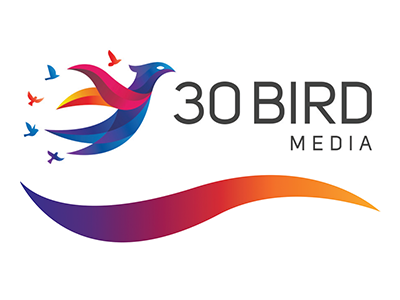 |
PMP® Certification: Passing the 2021 Exam |
40.00 |
PMP® Certification: Passing the 2021 Exam provides the basic knowledge needed to learn the concepts and skills necessary to pass the 2021 Project Management Professional (PMP) exam administered by the Project Management Institute (PMI). It is intended to be used alongside the PMBOK® Guide, Sixth Edition, which is useful as an ancillary reference and glossary.
The new release of this course (R2.0) includes a new chapter on agile approaches to, and tools for, the project life cycle. These methods address projects that require an adaptive project environment, iterative activities, and changing requirements. The standard example of adaptive project needs is that of software development and revision; however, agile methods are used today in many different project environments, from architecture to medical equipment and services. The new chapter (Managing projects with agility) was inserted at the end of the book. There were no other changes to the rest of the content, including the Exam Prep add-on.
This course assumes that you have project management and other educational experience, as required by PMI, in order to take the exam. In addition, it’s expected either that you have already applied to take the exam, or that you plan to do so while taking this course or shortly thereafter; this course contains instructions for doing so. |
 |
Designing Effective Indoor Play and Learning Environments for School-Age Programs |
2.00 |
Planning effective environments is the first step to planning an effective program. When environments are attractive, interesting, and comfortable, they provide a backdrop for a varied program that can address the developmental needs of school-age children. The look and feel of well-planned environments send messages that let children know they are welcome and valued. They are inviting and encourage children to get involved and stay engaged with program activities and experiences. |
 |
Course 15: Designing Effective Indoor School-Age Play and Learning Environments |
2.00 |
Planning effective environments is the first step to planning an effective program. When environments are attractive, interesting, and comfortable, they provide a backdrop for a varied program that can address the developmental needs of school-age children. The look and feel of well-planned environments send messages that let children know they are welcome and valued. They are inviting and encourage children to get involved and stay engaged with program activities and experiences |
 |
Making Plans and Developing Policies |
2.00 |
Planning and policy-making are closely linked to the development of quality school-age care programs. When school-age staff are skilled as planners and policy-makers, they can use these skills to design and implement high quality programs that benefit children, youth, and families. It is essential for school-age care professionals to recognize that it is important for policies to grow out of a vision of quality, and a mission that supports that vision. Therefore, creating a vision for quality, developing a program philosophy, and writing a clear mission statement are the first steps in program planning. It is also important for school-age care professionals to use a systematic process to develop goals and objectives, set priorities for accomplishing goals and objectives, and develop goal-based action plans that will help the school-age program achieve its mission. High quality school-age programs are led by professionals who understand how to use effective strategies for creating a continuous cycle of planning and evaluation that supports ongoing program improvement. |
 |
Course 29: Making Plans and Developing Policies |
2.00 |
Planning and policy-making are closely linked to the development of quality OST programs. When OST staff are skilled as planners and policy-makers, they can use these skills to design and implement high quality programs that benefit children, youth, and families. It is essential for OST professionals to recognize that it is important for policies to grow out of a vision of quality and a mission that supports that vision. Therefore, creating a vision for quality, developing a program philosophy, and writing a clear mission statement are the first steps in program planning. It is also important for OST professionals to use a systematic process to develop goals and objectives, set priorities for accomplishing goals and objectives, and develop goal-based action plans that will help the OST program achieve its mission. High quality OST programs are led by professionals who understand how to use effective strategies for creating a continuous cycle of planning and evaluation that supports ongoing program improvement. |
 |
Outdoor Personal Protective Equipment (PPE) |
0.50 |
Personal protective equipment, commonly referred to as “PPE,” is equipment worn to minimize exposure to various hazards. Examples of PPE include gloves, foot, and eye protection, protective hearing devices (earplugs, muffs), hard hats, respirators, and full-body suits. This course covers protecting yourself from hazardous work-related activities with Personal Protective Equipment. |
 |
Managing Performance: Performance Management Basics |
1.00 |
Performance management is a process that allows for ongoing communication between employees and managers that results in employees striving for, and reaching, their potential.
In this course you will learn to: define performance management and identify its common pitfalls, understand the importance of creating a performance management plan and the steps involved in establishing a plan, and identify the process for discussing and creating an effective job description. |
 |
Coaching: Coaching Diverse Employees |
1.34 |
People are different. Beliefs, behavior, learning pace, and personality vary from person to person. Some employees require extensive support to complete a project, while others perform better with fewer guidelines and more control. Still other employees need constant motivation to keep them focused on achieving goals.
As a coach, you must assess each employee’s situation, and determine the most effective coaching approach to implement. This versatility will help you recognize your employees’ needs, improve your communication skills, and make you a better coach.
In this course you will learn to: motivate employees by identifying their individual personality types, and build trusting relationships between employees and their coaches. |
 |
Coaching: Coaching Diverse Employees (Instructor Guide) |
1.34 |
People are different. Beliefs, behavior, learning pace, and personality vary from person to person. Some employees require extensive support to complete a project, while others perform better with fewer guidelines and more control. Still other employees need constant motivation to keep them focused on achieving goals.
As a coach, you must assess each employee’s situation, and determine the most effective coaching approach to implement. This versatility will help you recognize your employees’ needs, improve your communication skills, and make you a better coach.
In this course you will learn to: motivate employees by identifying their individual personality types, and build trusting relationships between employees and their coaches.
This Instructor's Edition of this course includes notes and suggestions to assist you in presenting the material, whether in an in-person classroom setting or as an instructor-led online or distance-learning course. It also provides you with the answers to questions found in mid-lesson activities, as well as in the quiz that concludes the course. |
 |
Penguins |
2.00 |
Penguins delight and fascinate zoo visitors, but there's more to these ocean-dwelling birds than meets the eye. From Antarctica to the equator, birds in the order Spheniscidae have adapted to a unique existence that is tied to the land and to the sea. |
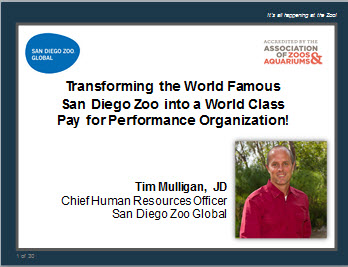 |
Pay for Performance |
1.00 |
Pay-for-Performance continues to be a major challenge for the majority of organizations as they try to find ways to make these programs meaningful to employees . Four years ago, the San Diego Zoo was struggling with how to best measure performance, manage goals and transform the organization into a pay-for-performance driven culture. Under the leadership of Tim Mulligan, the San Diego Zoo implemented a complete overhaul of its employee performance and talent management processes and systems, including appraisals and pay-for-performance. The end result was complete transformation of the Zoo's culture. Now the organization's more than 3,000 employees have clear goals and a link between day to day performance and their compensation which has resulted in greater accountability, increased productivity and higher employee morale. |
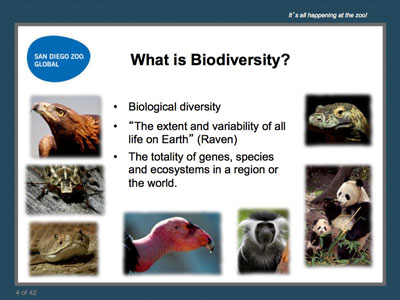 |
The Value of Biodiversity and its Link to Human Welfare |
1.00 |
Participants will explore the question: "What is the value of biodiversity?" We'll discuss biodiversity's value from intrinsic and utilitarian perspectives and discuss why saving Earth's species is a critically important matter for all humans. The personal link between biodiversity and human wellbeing has been demonstrated in numerous studies, a compelling body of research that we'll discuss here. Lastly we'll discuss the current plight of global biodiversity and how we can each personally help to alleviate threats. |
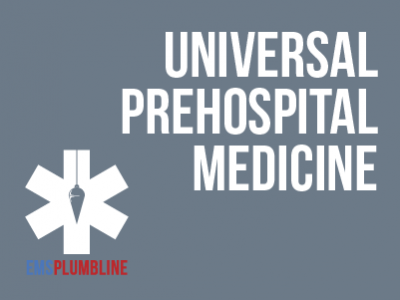 |
COVID-19 Pandemic—EMS Documentation |
1.00 |
Paramedics Mark Philippy and Ben Sensenbach take time in the Spring of 2020 to discuss the documentation concerns that are associated with COVID-19. This in-depth discussion will lead most providers to the conclusion that they are already doing good work and it should continue. This discussion is strong enough to lead the same providers to think slightly differently about what is done during a pandemic period and they may decide to make minor alterations in what the way the document after EMS responses. Final Exam: This multiple-choice exam is designed to test your knowledge of the material you just reviewed. You have three attempts to gain an 80% or higher on this exam. Please take your time and answer each question carefully. |
 |
Technical Rescue—EMS Considerations: Part 1 |
1.00 |
Paramedic, and longtime EMS educator, Aaron Horowitz sits down with medical director, Jeremy Cushman. The thought-provoking discussion that ensues covers a wide range of technical rescues. We believe that much can be done to treat the sick and injured patient during a technical rescue of any type if you prepare for the incident. Many of these concepts you will want to discuss with fellow responders if you have not done so already.
Final Exam: This multiple choice exam is designed to test your knowledge of the material you just reviewed. You have two attempts to gain an 80% or higher on this exam. Please take your time and answer each question carefully. |
 |
Constructing: Sepsis for Paramedics, Part 1—Overview |
1.00 |
Paramedic Michael Hoskins does a fantastic job discussing the gradual onset of this disease process with Medical Directors Jeremy Cushman and Christopher Galton. In this first of three segments, you will learn how we should look for sepsis and what questions every paramedic should ask. Final Exam: This multiple choice exam is designed to test your knowledge of the material you just reviewed. You have two attempts to gain an 80% or higher on this exam. Please take your time and answer each question carefully. |
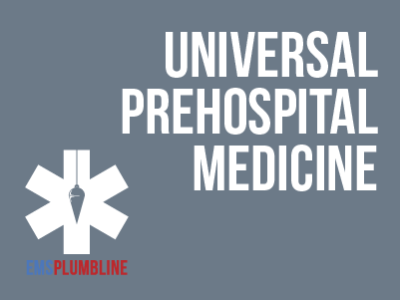 |
Pneumothorax and Hemothorax for EMTs |
1.00 |
Paramedic Instructor Peter Bonadonna discusses some of the most life threatening chest injures. |
 |
Commotio Cordis |
1.00 |
Paramedic Instructor Peter Bonadonna discusses his thoughts on Commotio Cordis in an effort to orient EMTs that are not familiar with the phenomena. |
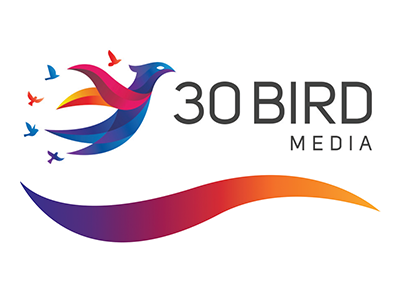 |
Microsoft Outlook 2019 Complete |
16.00 |
Outlook 2019 Complete provides the concepts and skills to be productive with Microsoft Outlook 2019, starting with fundamentals and working up to advanced tools and techniques.
This course maps to the objectives of the Microsoft Office Specialist exam for Outlook 2019. Objective coverage is marked throughout the course, and you can download an objective map. |
 |
Creating Respect and Safety |
2.00 |
Out-of-school time programs provide a safe space for children and youth, both physically and emotionally. Staff need to understand how to create safe environments to ensure that children and youth feel safe in order to fully participate in the program. This course will provide participants the opportunity to explore their own relationship to safety and support, set group agreements for the series, and discover their FRAME. |
 |
The Ethics of Animal Care |
2.00 |
Our industry is one that is at the forefront of the on-going ethical dialogue regarding animals, their uses, welfare and conservation. This course is designed to help animal care workers and others to better understand the role of ethics in their daily professional activity. The class explores the origins and evolving process for ethics associated with human-animal interactions, as well as, a range of current ethical issues and challenges faced by animal care professionals. |
 |
Organizational Communication: Leadership and Motivation |
1.00 |
Organizational communication relies on the communication skills of employees, managers, and leaders. The competence of leaders is reflected in their communication skills. Communication skills also play a major role in differentiating a manager and a leader. To become an effective leader, you need to understand the theories of leadership. The structure of an organization also determines the ability of a manager.
Although motivation resides within an individual, organizations can affect motivation through communication. To motivate employees, management must clearly outline its expectations, goals, and rewards. Organizational structure can affect the communication used to motivate employees, as well as other types of communication within the organization.
In this course you will learn to: describe how communication skills and leadership are related, and define the theories of motivation, and identify motivational tools and the impact of nonverbal behavior. |
 |
Organizational Communication: Leadership and Motivation (Instructor Guide) |
1.00 |
Organizational communication relies on the communication skills of employees, managers, and leaders. The competence of leaders is reflected in their communication skills. Communication skills also play a major role in differentiating a manager and a leader. To become an effective leader, you need to understand the theories of leadership. The structure of an organization also determines the ability of a manager.
Although motivation resides within an individual, organizations can affect motivation through communication. To motivate employees, management must clearly outline its expectations, goals, and rewards. Organizational structure can affect the communication used to motivate employees, as well as other types of communication within the organization.
In this course you will learn to: describe how communication skills and leadership are related, and define the theories of motivation, and identify motivational tools and the impact of nonverbal behavior.
This Instructor's Edition of this course includes notes and suggestions to assist you in presenting the material, whether in an in-person classroom setting, or as an instructor-led online or distance-learning course. It also provides you with the answers to questions found in mid-lesson activities, as well as in the quiz that concludes the course. |
 |
Effective Presentations: Building Presentations (Instructor Guide) |
1.17 |
Organization is extremely important in a presentation because the audience cannot follow your work if they become confused. Therefore, it is the responsibility of the presenter to help the audience understand the presentation from beginning to end.
This Instructor's Edition of this course includes notes and suggestions to assist you in presenting the material, whether in an in-person classroom setting, or as an instructor-led online or distance-learning course. It also provides you with the answers to questions found in mid-lesson activities, as well as in the quiz that concludes the course. |
 |
Exploring Individual Differences in School-Age Children: Implications for Programming |
2.00 |
One of the most significant challenges for staff in school-age programs is learning how to identify, manage, and respond appropriately to individual differences in a group setting. Some differences among children are the result of inborn characteristics and traits (e.g., physical characteristics, temperament, talents, race). Other differences are the result of external factors (e.g., the environment) or are cultivated as the child grows and develops (e.g., interests, skills, knowledge). The diverse needs, characteristics, interests, abilities, and skills of school-age children require a flexible atmosphere that supports diversity and choice for children with varying capacities for independent action. Staff who understand and appreciate individual differences in children are better equipped to plan and implement program experiences that help individual children grow and flourish in a group setting. |


























